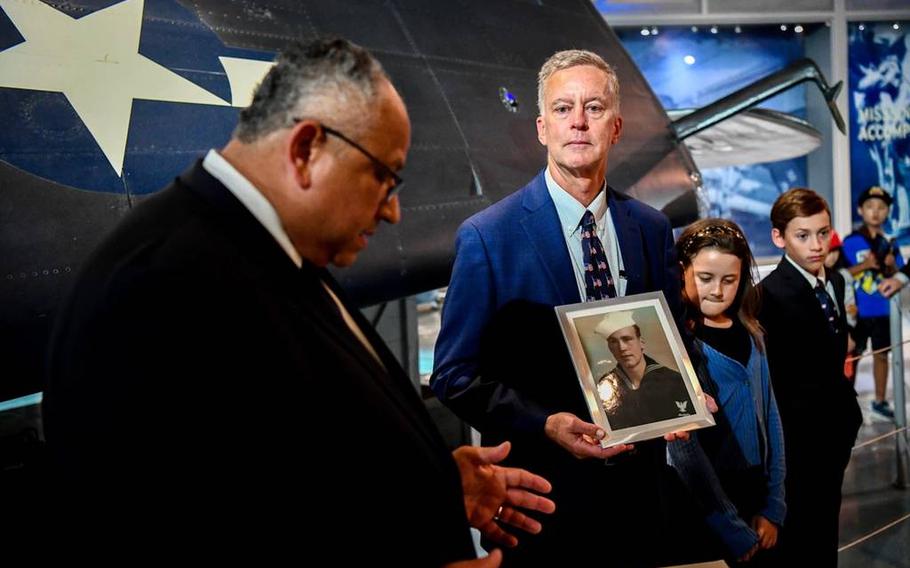
James Smith holds a photo of his father, Navy Petty Officer 3rd Class Peter L. Smith, on Aug. 16, 2023, at the Intrepid Sea, Air & Space Museum in New York City, where Navy Secretary Carlos Del Toro honored Peter Smith’s service in World War II. (U.S. Navy)
WASHINGTON — Navy veteran Peter L. Smith was posthumously awarded the Distinguished Flying Cross and Air Medal for his actions in combat during World War II.
“I am humbled by the opportunity to honor Peter L. Smith — one of our Navy’s hundreds of thousands of World War II veterans — for his service to our nation during a defining period in world history,” Navy Secretary Carlos Del Toro said Aug. 16 at the ceremony. “After the war, Smith, like so many members of this greatest generation, returned to their civilian careers, but forever remained proud of their service.”
Smith’s son, James Smith, accepted the awards on his father’s behalf during a ceremony aboard the Intrepid Sea, Air and Space Museum in New York. His father died in 2009.
“My father, like many thousands of his generation during the war, did his job — day in and day out. In less than four years, his dedication led to defeating the Nazis and the empire of Japan concurrently,” Smith said.
Third Class Petty Officer Peter Smith was a native of Troy, N.Y. He enlisted in the Navy on Feb. 2, 1942, two months after the Japanese attacks on Pearl Harbor. First rated as a storekeeper, Smith volunteered for flying duty, completing training as an aviation radioman and an air gunner.
Smith was assigned to Composite Squadron 28 based at Henderson Airfield on Guadalcanal in June 1943. During his time there, Smith flew as a member of a three-man crew in a TBF Avenger torpedo bomber and conducted 15 combat missions in support of troops on the ground at New Georgia, which is part of the Solomon Islands.
Smith returned to the United States but later deployed again to the Pacific in 1944 with the newly designated Torpedo Squadron 28, or VT-28, operating as an aircraft carrier-based squadron off the USS Monterey. During his time with the squadron, Smith flew in operations to retake Marianas, Saipan, Tinian and Southern Palau from Japanese forces. He also supported the assaults on the Philippines and strikes against Okinawa. Smith flew more than 150 combat and support missions during his 11 months with VT-28 before being honorably discharged in February 1946, after the conclusion of the war.
Congress established the Distinguished Flying Cross on July 2, 1926. It can be awarded to Navy, Marine Corps or Coast Guard personnel, while serving in the capacity of the armed forces, who distinguish themselves for heroism or outstanding achievement while participating in aerial flight, the Navy said.
The Air Medal is awarded for sustained performance while participating in aerial flight under combat conditions.
Smith joins Charles Lindbergh and the Wright Brothers, as well as fellow Navy recipients President George H.W. Bush and Sen. John McCain to receive the Distinguished Cross.
“To Petty Officer Smith’s family, I am confident there is no doubt in your minds that his actions met the criteria above for these two awards. His devotion to duty in support of his fellow sailors, Marines, airmen, and soldiers was indeed unwavering throughout his time in service, and I have no doubt you take pride in his accomplishments to keep our nation free,” Del Toro said.